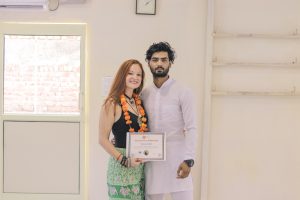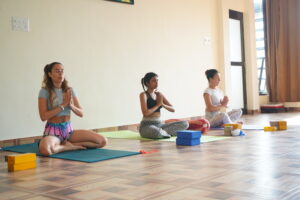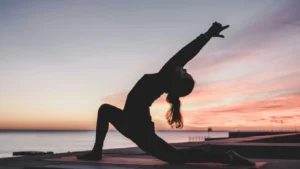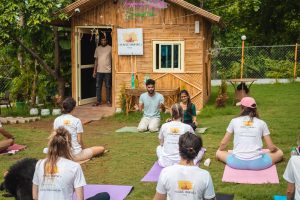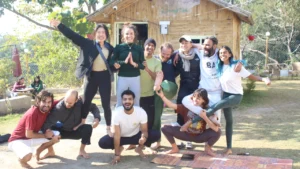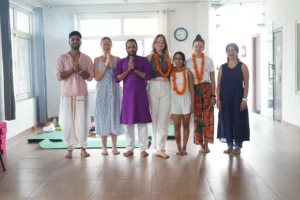In the diverse landscape of yoga, Hatha Yoga stands as a foundational practice, offering a comprehensive approach to physical health, mental clarity, and inner harmony. This exploration delves into the essence of Hatha Yoga, examining its origins, benefits, and key asanas (postures) to provide a comprehensive understanding of this transformative practice.
Understanding Hatha Yoga
The term “Hatha” is derived from two Sanskrit roots: “Ha,” representing the sun, and “Tha,” symbolizing the moon. This duality signifies the inherent balance of opposing forces—active and passive, masculine and feminine, strength and flexibility—within the individual. Hatha Yoga, therefore, seeks to harmonize these energies, fostering equilibrium between mind and body.
More than just a series of physical exercises, Hatha Yoga is a holistic discipline that integrates asanas (postures), pranayama (breath control), and meditation. It aims to purify and strengthen the physical body, calm and focus the mind, and cultivate a deeper connection with one’s inner self. Unlike more vigorous styles like Vinyasa or Ashtanga, Hatha Yoga emphasizes slower, controlled movements, sustained holds, and mindful awareness, making it accessible to practitioners of all levels, particularly beginners and those seeking a gentler, more introspective practice.
The Multifaceted Benefits of Hatha Yoga
The practice of Hatha Yoga offers a wide spectrum of benefits that extend across physical, mental, and spiritual dimensions:
Physical Benefits:
- Enhanced Flexibility: Hatha Yoga asanas systematically stretch and lengthen muscles, improving joint mobility and reducing stiffness. Regular practice increases range of motion, promoting greater ease and fluidity in daily activities.
- Increased Strength and Tone: While often associated with stretching, Hatha Yoga also builds strength and muscle endurance. Holding postures engages various muscle groups, particularly in the core, legs, arms, and back, leading to improved muscle tone, stability, and functional strength.
- Improved Posture and Body Awareness: Hatha Yoga cultivates heightened body awareness and promotes proper alignment. By strengthening supporting muscles and improving spinal flexibility, it helps correct postural imbalances, reducing back and neck pain often associated with sedentary lifestyles.
- Support for Physical Health: Regular practice can contribute to improved cardiovascular health, lower blood pressure, and enhanced respiratory function. The physical movements and breathing exercises can also aid digestion and support the body’s natural detoxification processes.
Mental and Emotional Benefits:
- Stress and Anxiety Reduction: Hatha Yoga has a profound calming effect on the nervous system. Controlled breathing techniques (pranayama) and mindful movement activate the parasympathetic nervous system, responsible for the “rest and digest” response. This helps regulate stress hormones like cortisol, promoting relaxation, reducing anxiety, and fostering a sense of inner peace.
- Improved Mental Clarity and Focus: The combination of physical postures and focused breathing clears mental clutter and enhances concentration. The meditative aspect of Hatha Yoga encourages mindfulness, bringing awareness to the present moment and reducing mental distractions.
- Emotional Regulation: By connecting with the breath and body, Hatha Yoga provides tools for managing emotions and cultivating emotional resilience. The practice can help individuals develop greater self-awareness and a deeper understanding of their emotional landscape.
Spiritual Benefits:
- Cultivating Self-Awareness: Hatha Yoga encourages introspection and self-discovery. By turning attention inward, practitioners develop a greater understanding of their physical sensations, thoughts, and emotions.
- Promoting Inner Peace and Harmony: The practice fosters a sense of inner peace and harmony by balancing opposing energies and cultivating a deeper connection with oneself.
- Supporting Personal Growth: Hatha Yoga can be a powerful tool for personal growth and transformation. By cultivating self-awareness, mindfulness, and inner strength, it empowers individuals to navigate life’s challenges with greater resilience and equanimity.
Key Hatha Yoga Asanas
Hatha Yoga encompasses a vast repertoire of asanas, each with unique benefits. The following are some fundamental postures suitable for beginners:
- Tadasana (Mountain Pose): This foundational standing pose establishes proper alignment and grounding. Stand with feet together, weight evenly distributed, shoulders relaxed, and arms at your sides. Engage your core and lengthen your spine, feeling a sense of upward extension.
- Adho Mukha Svanasana (Downward-Facing Dog): Starting on hands and knees, lift your hips up and back, forming an inverted “V” shape. Press firmly through your hands and feet, lengthening your spine and stretching your hamstrings and calves. Modification: If hamstrings are tight, keep a slight bend in the knees.
- Trikonasana (Triangle Pose): Stand with feet wide apart, turn one foot outward, and extend your arms parallel to the floor. Hinge at your hips and reach down towards your front foot, extending your opposite arm towards the ceiling. Modification: If you can’t reach the floor, rest your hand on a block or your shin.
- Bhujangasana (Cobra Pose): Lie on your stomach with hands beneath your shoulders. Press through your hands to lift your chest off the floor, keeping your elbows slightly bent. Engage your back muscles and avoid straining your lower back. Caution: If you have lower back pain, lift your chest only slightly.
- Virabhadrasana I (Warrior I Pose): Step one leg back and bend your front knee to 90 degrees, keeping your back leg straight. Raise your arms overhead, palms facing each other. Keep your torso upright and your hips facing forward.
- Setu Bandhasana (Bridge Pose): Lie on your back with knees bent and feet flat on the floor. Lift your hips off the floor, engaging your glutes and hamstrings. Keep your shoulders and feet grounded.
- Savasana (Corpse Pose): Lie on your back with arms at your sides, palms facing up. Close your eyes and allow your body to completely relax. Focus on your breath and release any tension. This pose is crucial for integrating the benefits of the practice.
Conclusion
Hatha Yoga is a powerful tool for self-discovery and holistic well-being.Whether you’re a beginner seeking an introduction to Hatha Yoga or an experienced practitioner looking to deepen your knowledge, Sage Yoga House in Rishikesh offers programs to support your journey. We provide comprehensive teacher training and enriching yoga retreats in the heart of the yoga capital. Contact us or WhatsApp us for more information on our Hatha Yoga offerings and other yoga courses.



